A distributed algorithm for deadlock detection and resolution
- 格式:pdf
- 大小:22.08 KB
- 文档页数:5
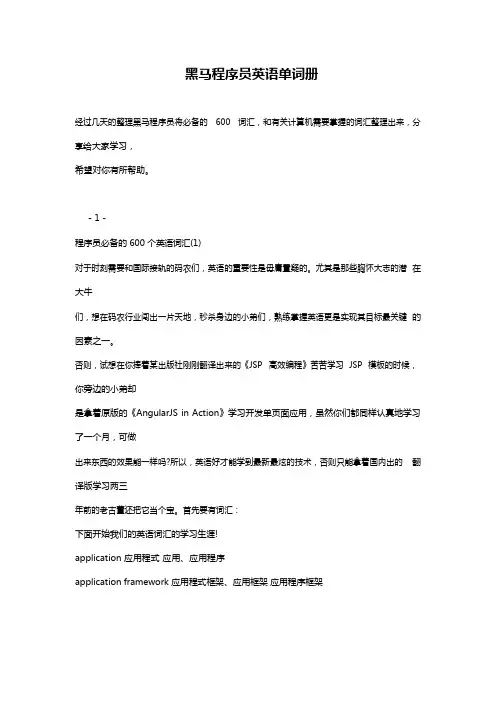
黑马程序员英语单词册经过几天的整理黑马程序员将必备的600词汇,和有关计算机需要掌握的词汇整理出来,分享给大家学习,希望对你有所帮助。
- 1 -程序员必备的 600 个英语词汇(1)对于时刻需要和国际接轨的码农们,英语的重要性是毋庸置疑的。
尤其是那些胸怀大志的潜在大牛们,想在码农行业闯出一片天地,秒杀身边的小弟们,熟练掌握英语更是实现其目标最关键的因素之一。
否则,试想在你捧着某出版社刚刚翻译出来的《JSP高效编程》苦苦学习JSP模板的时候,你旁边的小弟却是拿着原版的《AngularJS in Action》学习开发单页面应用,虽然你们都同样认真地学习了一个月,可做出来东西的效果能一样吗?所以,英语好才能学到最新最炫的技术,否则只能拿着国内出的翻译版学习两三年前的老古董还把它当个宝。
首先要有词汇:下面开始我们的英语词汇的学习生涯!application 应用程式应用、应用程序application framework 应用程式框架、应用框架应用程序框架architecture 架构、系统架构体系结构argument 引数(传给函式的值)。
叁见 parameter 叁数、实质叁数、实叁、自变量array 阵列数组arrow operator arrow(箭头)运算子箭头操作符assembly 装配件assembly language 组合语言汇编语言assert(ion) 断言assign 指派、指定、设值、赋值赋值assignment 指派、指定赋值、分配assignment operator 指派(赋值)运算子 = 赋值操作符associated 相应的、相关的相关的、关联、相应的associative container 关联式容器(对应 sequential container)关联式容器atomic 不可分割的原子的attribute 属性属性、特性audio 音讯音频A.I. 人工智慧人工智能background 背景背景(用於图形着色)- 2 -后台(用於行程)backward compatible 回溯相容向下兼容bandwidth 频宽带宽base class 基础类别基类base type 基础型别 (等同於 base class)batch 批次(意思是整批作业) 批处理benefit 利益收益best viable function 最佳可行函式最佳可行函式(从 viable functions 中挑出的最佳吻合者)binary search 二分搜寻法二分查找binary tree 二元树二叉树binary function 二元函式双叁函数binary operator 二元运算子二元操作符binding 系结绑定bit 位元位bit field 位元栏位域bitmap 位元图位图bitwise 以 bit 为单元逐一┅bitwise copy 以bit 为单元进行复制;位元逐一复制位拷贝block 区块,区段块、区块、语句块boolean 布林值(真假值,true 或 false)布尔值border 边框、框线边框brace(curly brace) 大括弧、大括号花括弧、花括号bracket(square brakcet) 中括弧、中括号方括弧、方括号breakpoint 中断点断点build 建造、构筑、建置(MS 用语)- 3 -build-in 内建内置bus 汇流排总线business 商务,业务业务buttons 按钮按钮byte 位元组(由 8 bits 组成) 字节cache 快取高速缓存call 呼叫、叫用调用callback 回呼回调call operator call(函式呼叫)运算子调用操作符(同 function call operator)candidate function 候选函式候选函数(在函式多载决议程序中出现的候选函式)chain 串链(例 chain of function calls) 链character 字元字符check box 核取方块 (i.e. check button) 复选框checked exception 可控式异常(Java)check button 方钮 (i.e. check box) 复选按钮child class 子类别(或称为 derived class, subtype) 子类class 类别类class body 类别本体类体class declaration 类别宣告、类别宣告式类声明class definition 类别定义、类别定义式类定义class derivation list 类别衍化列类继承列表class head 类别表头类头class hierarchy 类别继承体系, 类别阶层类层次体系class library 类别程式库、类别库类库- 4 -class template 类别模板、类别范本类模板class template partial specializations类别模板偏特化类模板部分特化class template specializations类别模板特化类模板特化cleanup 清理、善后清理、清除client 客端、客户端、客户客户client-server 主从架构客户/服务器clipboard 剪贴簿剪贴板clone 复制克隆collection 群集集合combo box 复合方块、复合框组合框command line 命令列命令行(系统文字模式下的整行执行命令)communication 通讯通讯compatible 相容兼容compile time 编译期编译期、编译时compiler 编译器编译器component 组件组件composition 复合、合成、组合组合computer 电脑、计算机计算机、电脑concept 概念概念concrete 具象的实在的concurrent 并行并发configuration 组态配置connection 连接,连线(网络,资料库) 连接- 5 -constraint 约束(条件)construct 构件构件container 容器容器(存放资料的某种结构如 list, vector...) containment 内含包容context 背景关系、周遭环境、上下脉络环境、上下文control 控制元件、控件控件console 主控台控制台const 常数(constant 的缩写,C++ 关键字) constant 常数(相对於 variable) 常量constructor(ctor) 建构式构造函数(与 class 同名的一种 member functions)copy (v) 复制、拷贝拷贝copy (n) 复件, 副本cover 涵盖覆盖create 创建、建立、产生、生成创建creation 产生、生成创建cursor 游标光标custom订制、自定定制data 资料数据database 资料库数据库database schema 数据库结构纲目data member 资料成员、成员变数数据成员、成员变量data structure 资料结构数据结构datagram 资料元数据报文dead lock 死结死锁- 6 -debug 除错调试debugger 除错器调试器declaration 宣告、宣告式声明deduction 推导(例:template argument deduction) 推导、推断default 预设缺省、默认defer 延缓推迟define 定义预定义definition 定义、定义区、定义式定义delegate 委派、委托、委任委托delegation (同上)demarshal 反编列散集dereference 提领(取出指标所指物体的内容) 解叁考dereference operator dereference(提领)运算子 * 解叁考操作符derived class 衍生类别派生类design by contract 契约式设计design pattern 设计范式、设计样式设计模式※ 最近我比较喜欢「设计范式」一词destroy 摧毁、销毁destructor 解构式析构函数device 装置、设备设备dialog对话窗、对话盒对话框directive 指令(例:using directive) (编译)指示符directory 目录目录disk 碟盘dispatch分派分派distributed computing 分布式计算 (分布式电算) 分布式计算- 7 -分散式计算 (分散式电算)document 文件文档dot operator dot(句点)运算子 . (圆)点操作符driver 驱动程式驱动(程序)dynamic binding 动态系结动态绑定今天的英语学习就到这了!!!!- 8 -程序员必备的 600 个英语词汇(2)哥是来吐槽的,虽说英语很重要,对于每一位程序员,非常重要,每一行代码,都是密密麻麻的英文字母重要,有时还要去苦思深虑的去为变量、方法、类取其一个名字,思前想后,一个又长又难懂的名字诞生了!当时一阵欣慰,日后,再见,一阵伤感,这到底是个毛意思?efficiency 效率效率efficient 高效高效end user 终端用户entity 物体实体、物体encapsulation 封装封装enclosing class 外围类别(与巢状类别 nested class 有关)外围类enum (enumeration) 列举(一种 C++ 资料型别) 枚举enumerators 列举元(enemy 型别中的成员) 枚举成员、枚举器equal 相等相等equality 相等性相等性equality operator equality(等号)运算子 == 等号操作符equivalence 等价性、等同性、对等性等价性equivalent等价、等同、对等等价escape code 转义码转义码evaluate 评估、求值、核定评估event 事件事件event driven 事件驱动的事件驱动的exception 异常情况异常exception declaration 异常宣告(ref. C++ Primer 3/e, 11.3)异常声明exception handling 异常处理、异常处理机制异常处理、异常处理机制exception specification 异常规格(ref. C++ Primer 3/e, 11.4)异常规范exit 退离(指离开函式时的那一个执行点) 退出- 9 -explicit 明白的、明显的、显式显式export 汇出引出、导出expression 运算式、算式表达式facility 设施、设备设施、设备feature 特性field 栏位,资料栏(Java) 字段, 值域(Java)file 档案文件firmware 韧体固件flag 旗标标记flash memory 快闪记忆体闪存flexibility 弹性灵活性flush 清理、扫清刷新font 字型字体form 表单(programming 用语) 窗体formal parameter 形式叁数形式叁数forward declaration 前置宣告前置声明forwarding 转呼叫,转发转发forwarding function 转呼叫函式,转发函式转发函数fractal 碎形分形framework 框架框架full specialization 全特化(ref. partial specialization) function 函式、函数函数function call operator 同 call operatorfunction object 函式物件(ref. C++ Primer 3/e, 12.3) 函数对象function overloaded resolution函式多载决议程序函数重载解决(方案)- 10 -functionality 功能、机能功能function template 函式模板、函式范本函数模板factor 仿函式仿函式、函子game 游戏游戏generate 生成generic 泛型、一般化的一般化的、通用的、泛化generic algorithm 泛型演算法通用算法getter (相对於 setter) 取值函式global 全域的(对应於 local) 全局的global object 全域物件全局对象global scope resolution operator全域生存空间(范围决议)运算子 :: 全局范围解析操作符group 群组group box 群组方块分组框guard clause 卫述句 (Refactoring, p250) 卫语句GUI 图形介面图形界面hand shaking 握手协商handle 识别码、识别号、号码牌、权柄句柄handler 处理常式处理函数hard-coded 编死的硬编码的hard-copy 硬拷图屏幕截图hard disk 硬碟硬盘hardware 硬体硬件hash table 杂凑表哈希表、散列表header file 表头档、标头档头文件heap 堆积堆- 11 -hierarchy 阶层体系层次结构(体系)hook 挂钩钩子hyperlink 超链结超链接icon 图示、图标图标IDE 整合开发环境集成开发环境identifier 识别字、识别符号标识符if and only if 若且唯若当且仅当Illinois 伊利诺伊利诺斯image 影像图象immediate base 直接的(紧临的)上层 base class。
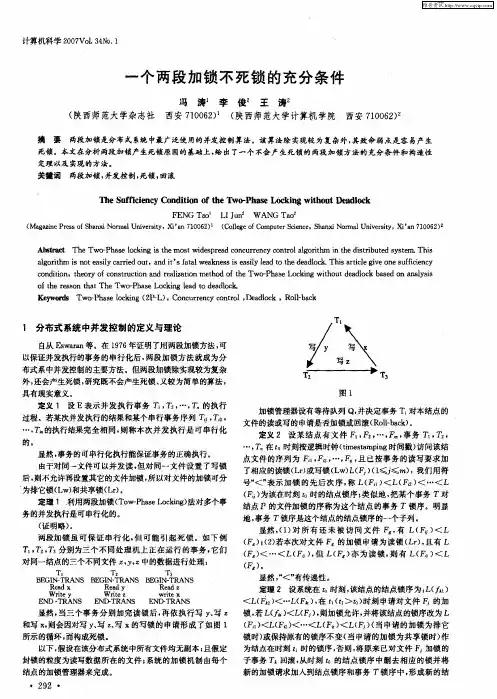
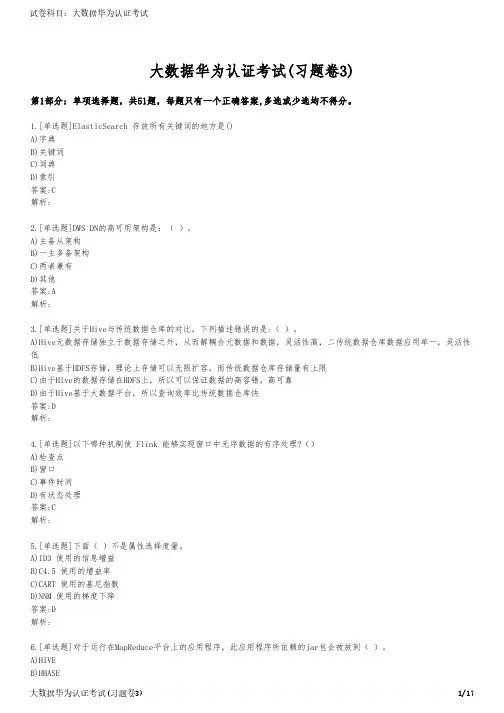
大数据华为认证考试(习题卷3)第1部分:单项选择题,共51题,每题只有一个正确答案,多选或少选均不得分。
1.[单选题]ElasticSearch 存放所有关键词的地方是()A)字典B)关键词C)词典D)索引答案:C解析:2.[单选题]DWS DN的高可用架构是:( )。
A)主备从架构B)一主多备架构C)两者兼有D)其他答案:A解析:3.[单选题]关于Hive与传统数据仓库的对比,下列描述错误的是:( )。
A)Hive元数据存储独立于数据存储之外,从而解耦合元数据和数据,灵活性高,二传统数据仓库数据应用单一,灵活性低B)Hive基于HDFS存储,理论上存储可以无限扩容,而传统数据仓库存储量有上限C)由于Hive的数据存储在HDFS上,所以可以保证数据的高容错,高可靠D)由于Hive基于大数据平台,所以查询效率比传统数据仓库快答案:D解析:4.[单选题]以下哪种机制使 Flink 能够实现窗口中无序数据的有序处理?()A)检查点B)窗口C)事件时间D)有状态处理答案:C解析:5.[单选题]下面( )不是属性选择度量。
A)ID3 使用的信息增益B)C4.5 使用的增益率C)CART 使用的基尼指数D)NNM 使用的梯度下降答案:D解析:C)HDFSD)DB答案:C解析:7.[单选题]关于FusionInsight HD Streaming的Supervisor描述正确的是:( )。
A)Supervisor负责资源的分配和任务的调度B)Supervisor负责接受Nimbus分配的任务,启动停止属于自己管理的Worker进程C)Supervisor是运行具体处理逻辑的进程D)Supervisor是在Topology中接收数据然后执行处理的组件答案:B解析:8.[单选题]在有N个节点FusionInsight HD集群中部署HBase时、推荐部署( )个H Master进程,( )个Region Server进程。
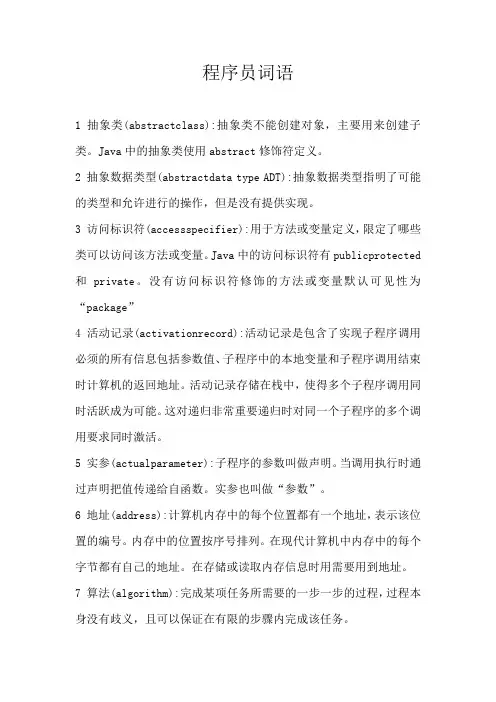
程序员词语1 抽象类(abstractclass):抽象类不能创建对象,主要用来创建子类。
Java中的抽象类使用abstract修饰符定义。
2 抽象数据类型(abstractdata type ADT):抽象数据类型指明了可能的类型和允许进行的操作,但是没有提供实现。
3 访问标识符(accessspecifier):用于方法或变量定义,限定了哪些类可以访问该方法或变量。
Java中的访问标识符有publicprotected 和private。
没有访问标识符修饰的方法或变量默认可见性为“package”4 活动记录(activationrecord):活动记录是包含了实现子程序调用必须的所有信息包括参数值、子程序中的本地变量和子程序调用结束时计算机的返回地址。
活动记录存储在栈中,使得多个子程序调用同时活跃成为可能。
这对递归非常重要递归时对同一个子程序的多个调用要求同时激活。
5 实参(actualparameter):子程序的参数叫做声明。
当调用执行时通过声明把值传递给自函数。
实参也叫做“参数”。
6 地址(address):计算机内存中的每个位置都有一个地址,表示该位置的编号。
内存中的位置按序号排列。
在现代计算机中内存中的每个字节都有自己的地址。
在存储或读取内存信息时用需要用到地址。
7 算法(algorithm):完成某项任务所需要的一步一步的过程,过程本身没有歧义,且可以保证在有限的步骤内完成该任务。
8 阿尔法颜色组成(alphacolor component):颜色组成用来描述颜色的透明度或不透明度。
阿尔法组成越高,颜色越不透明。
9 API:应用编程接口。
针对软件包或“工具箱”的接口说明。
API包含了工具箱中所有类或子程序及其使用说明。
10 Applet:与可以单独运行的应用程序不同,Applet是一种在Web 浏览器中运行在Web页面上的Java程序。
11 动画(animation):由一组静态图片快速显示展示出动态效果。
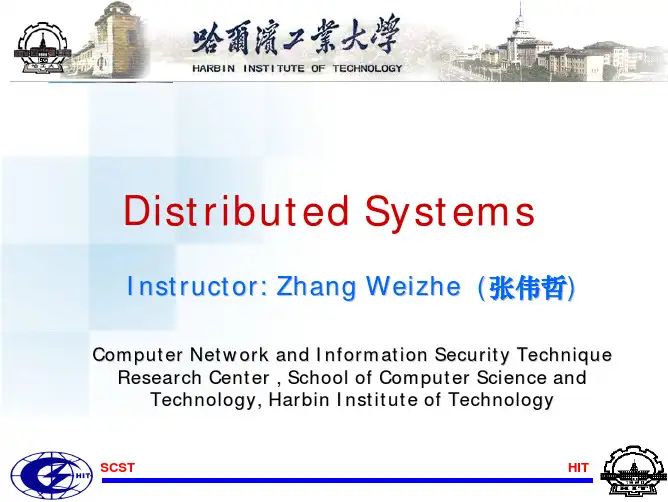
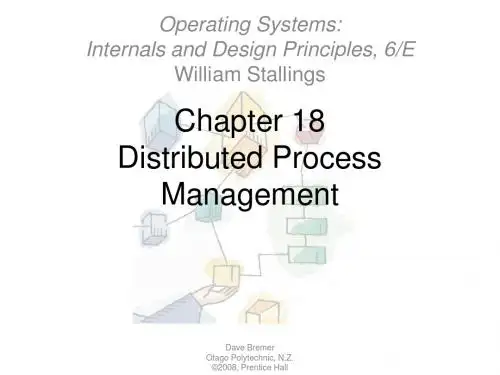
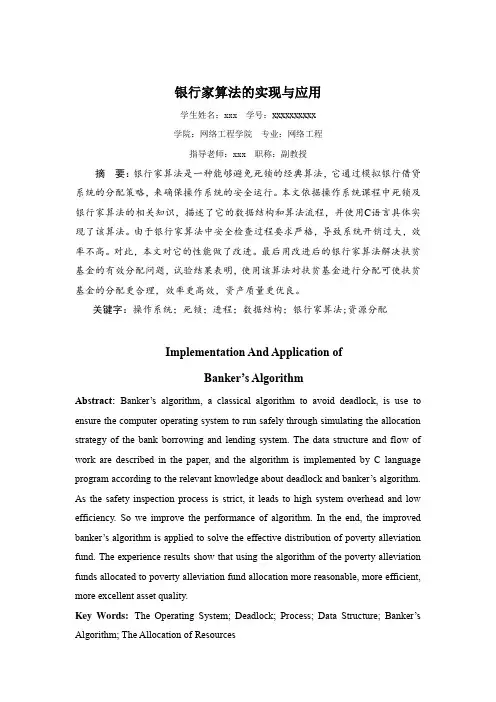
银行家算法的实现与应用学生姓名:xxx 学号:xxxxxxxxxx学院:网络工程学院专业:网络工程指导老师:xxx 职称:副教授摘要:银行家算法是一种能够避免死锁的经典算法,它通过模拟银行借贷系统的分配策略,来确保操作系统的安全运行。
本文依据操作系统课程中死锁及银行家算法的相关知识,描述了它的数据结构和算法流程,并使用C语言具体实现了该算法。
由于银行家算法中安全检查过程要求严格,导致系统开销过大,效率不高。
对此,本文对它的性能做了改进。
最后用改进后的银行家算法解决扶贫基金的有效分配问题,试验结果表明,使用该算法对扶贫基金进行分配可使扶贫基金的分配更合理,效率更高效,资产质量更优良。
关键字:操作系统;死锁;进程;数据结构;银行家算法;资源分配Implementation And Application ofBanker’s AlgorithmAbstract: Banker’s algorithm, a classical algorithm to avoid deadlock, is use to ensure the computer operating system to run safely through simulating the allocation strategy of the bank borrowing and lending system. The data structure and flow of work are described in the paper, and the algorithm is implemented by C language program according to the relevant knowledge about deadlock and banker’s algorithm. As the safety inspection process is strict, it leads to high system overhead and low efficiency. So we improve the performance of algorithm. In the end, the improved banker’s algorithm is applied to solve the effective distribution of poverty alleviation fund. The experience results show that using the algorithm of the poverty alleviation funds allocated to poverty alleviation fund allocation more reasonable, more efficient, more excellent asset quality.Key Words:The Operating System; Deadlock; Process; Data Structure; Banker’s Algorithm; The Allocation of Resources引言研究银行家算法就不得不提到死锁[1],在操作系统课程中,死锁作为一个重要概念在整个操作系统中占有举足轻重的地位。

1.1What are the three main purposes of an operating system?(1) Interface between the hardware and user;(2) manage the resource of hardware and software;(3) abstraction of resource;1.2 List the four steps that are necessary to run a program on a completely dedicated machine. Preprocessing > Processing > Linking > Executing.1.6 Define the essential properties of the following types of operating systems:a. Batchb. Interactivec. Time sharingd. Real timee. Networkf. Distributed1.7 We have stressed the need for an operating system to make efficient use of the computing hardware. When is it appropriate for the operating system to forsake this principle and to“waste” resources? Why is such a system not really wasteful?2.2 How does the distinction between monitor mode and user mode function as a rudimentary form of protection (security) system?2.3 What are the differences between a trap and an interrupt? What is the use of each function?2.5 Which of the following instructions should be privileged?a. Set value of timer.b. Read the clock.c. Clear memory.d. Turn off interrupts.e. Switch from user to monitor mode.2.8 Protecting the operating system is crucial to ensuring that the computer system operates correctly. Provision of this protection is the reason behind dual-mode operation, memory protection, and the timer. To allow maximum flexibility, however, we would also like to place minimal constraints on the user.The following is a list of operations that are normally protected. What is the minimal set of instructions that must be protected?a. Change to user mode.b. Change to monitor mode.c. Read from monitor memory.d. Write into monitor memory.e. Fetch an instruction from monitor memory.f. Turn on timer interrupt.g. Turn off timer interrupt.3.6 List five services provided by an operating system. Explain how each provides convenience to the users. Explain also in which cases it would be impossible for user-level programs to provide these services.3.7 What is the purpose of system calls?3.10 What is the purpose of system programs?4.1 MS-DOS provided no means of concurrent processing. Discuss three major complications that concurrent processing adds to an operating system.4.6 The correct producer–consumer algorithm in Section 4.4 allows only n-1 buffers to be full at any one time. Modify the algorithm to allow all buffers to be utilized fully.5.1 Provide two programming examples of multithreading giving improve performance overa single-threaded solution.5.3 What are two differences between user-level threads and kernel-level threads? Under what circumstances is one type better than the other?6.3 Consider the following set of processes, with the length of the CPU-burst time given inmilliseconds:Process Burst Time PriorityP1 10 3P2 1 1P3 2 3P4 1 4P5 5 2The processes are assumed to have arrived in the order P1, P2, P3, P4, P5, all at time 0.a. Draw four Gantt charts illustrating the execution of these processes using FCFS, SJF, a nonpreemptive priority (a smaller priority number implies a higher priority), and RR (quantum = 1) scheduling.b. What is the turnaround time of each process for each of the scheduling algorithms in part a?c. What is the waiting time of each process for each of the scheduling algorithms in part a?d. Which of the schedules in part a results in the minimal average waiting time (over all processes)?Answer:6.4 Suppose that the following processes arrive for execution at the times indicated. Eachprocess will run the listed amount of time. In answering the questions, use nonpreemptive scheduling and base all decisions on the information you have at the time the decision must be made.a. What is the average turnaround time for these processes with the FCFS scheduling algorithm?b. What is the average turnaround time for these processes with the SJF scheduling algorithm?c. The SJF algorithm is supposed to improve performance, but notice that we chose to run process P1 at time 0 because we did not know that two shorter processes would arrive soon. Compute what the average turnaround time will be if the CPU is leftidle for the first 1 unit and then SJF scheduling is used. Remember that processes P1 and P2 are waiting during this idle time, so their waiting time may increase. This algorithm could be known as future-knowledge scheduling.6.10 Explain the differences in the degree to which the following scheduling algorithms discriminate in favor of short processes:a. FCFSb. RRc. Multilevel feedback queues7.7 Show that, if the wait and signal operations are not executed atomically,then mutual exclusion may be violated.7.8 The Sleeping-Barber Problem. A barbershop consists of a waiting room with n chairs and the barber room containing the barber chair. If there are no customers to be served,the barber goes to sleep. If a customer enters the barbershop and all chairs are occupied, then the customer leaves the shop.If the barber is busy but chairs are available, then the customer sits in one of the free chairs. If the barber is asleep, the customer wakes up the barber. Write a program to coordinate the barber and the customers.8.2 Is it possible to have a deadlock involving only one single process? Explain your answer.8.4 Consider the traffic deadlock depicted in Figure 8.11.a. Show that the four necessary conditions for deadlock indeed hold in this example.b. State a simple rule that will avoid deadlocks in this system.8.13 Consider the following snapshot of a system:Allocation Max AvailableA B C D A B C D A B C DP0 0 0 1 2 0 0 1 2 1 5 2 0P1 1 0 0 0 1 7 5 0P2 1 3 5 4 2 3 5 6P3 0 6 3 2 0 6 5 2P4 0 0 1 4 0 6 5 6Answer the following questions using th e banker’s algorithm:a. What is the content of the matrix Need?b. Is the system in a safe state?c. If a request from process P1 arrives for (0,4,2,0), can the request be granted immediately?9.5 Given memory partitions of 100K, 500K, 200K, 300K, and 600K (in order), how would each of the First-fit, Best-fit, and Worst-fit algorithms place processes of 212K, 417K, 112K, and 426K (in order)? Which algorithm makes the most efficient use of memory?9.8 Consider a logical address space of eight pages of 1024 words each, mapped onto a physicalmemory of 32 frames.a. How many bits are there in the logical address?b. How many bits are there in the physical address?9.16 Consider the following segment table:Segment Base Length0219 60012300 14290 10031327 58041952 96What are the physical addresses for the following logical addresses?a. 0,430b. 1,10c. 2,500d. 3,400e. 4,11210.2 Assume that you have a page reference string for a process with m frames (initially all empty). The page reference string has length p with n distinct page numbers occur in it. For any page-replacement algorithms,a. What is a lower bound on the number of page faults?b. What is an upper bound on the number of page faults?10.11 Consider the following page reference string:1, 2, 3, 4, 2, 1, 5, 6, 2, 1, 2, 3, 7, 6, 3, 2, 1, 2, 3, 6.How many page faults would occur for the following replacement algorithms, assuming one, two, three, four, five, six, or seven frames? Remember all frames are initially empty, so your first unique pages will all cost one fault each.LRU replacementFIFO replacementOptimal replacement11.7 Explain the purpose of the open and close operations.11.9 Give an example of an application in which data in a file should be accessed in the following order:a. Sequentiallyb. Randomly11.12 Consider a system that supports 5000 users. Suppose that you want to allow 4990 of these users to be able to access one file.a. How would you specify this protection scheme in UNIX?b. Could you suggest another protection scheme that can be used more effectively for this purpose than the scheme provided by UNIX?12.1 Consider a file currently consisting of 100 blocks. Assume that the file control block (andthe index block, in the case of indexed allocation) is already in memory. Calculate how many disk I/O operations are required for contiguous, linked, and indexed (single-level) allocation strategies, if, for one block, the following conditions hold. In the contiguousallocation case, assume that there is no room to grow in the beginning, but there is room to grow in the end. Assume that the block information to be added is stored in memory.a. The block is added at the beginning.b. The block is added in the middle.c. The block is added at the end.d. The block is removed from the beginning.e. The block is removed from the middle.f. The block is removed from the end.13.2 Consider the following I/O scenarios on a single-user PC.a. A mouse used with a graphical user interfaceb. A tape drive on a multitasking operating system (assume no device preallocation is available)c. A disk drive containing user filesd. A graphics card with direct bus connection, accessible through memory-mappedI/OFor each of these I/O scenarios, would you design the operating system to use buffering, spooling, caching, or a combination? Would you use polled I/O, or interrupt-driven I/O?Give reasons for your choices.14.2 Suppose that a disk drive has 5000 cylinders, numbered 0 to 4999. The drive is currently serving a request at cylinder 143, and the previous request was at cylinder 125. The queue of pending requests, in FIFO order, is86, 1470, 913, 1774, 948, 1509, 1022, 1750, 130Starting from the current head position, what is the total distance (in cylinders) that the disk arm moves to satisfy all the pending requests, for each of the following diskschedulingalgorithms?a. FCFSb. SSTFc. SCANd. LOOKe. C-SCAN1.1 1.62.3 2.53.7 6.3 6。
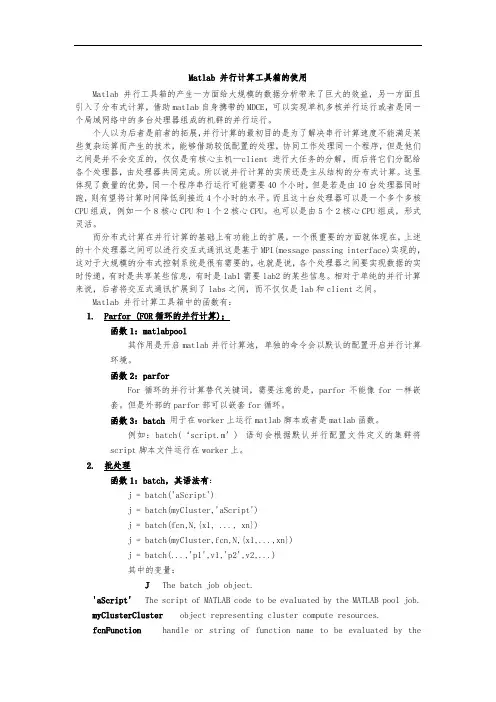
Matlab 并行计算工具箱的使用Matlab并行工具箱的产生一方面给大规模的数据分析带来了巨大的效益,另一方面且引入了分布式计算,借助matlab自身携带的MDCE,可以实现单机多核并行运行或者是同一个局域网络中的多台处理器组成的机群的并行运行。
个人以为后者是前者的拓展,并行计算的最初目的是为了解决串行计算速度不能满足某些复杂运算而产生的技术,能够借助较低配置的处理,协同工作处理同一个程序,但是他们之间是并不会交互的,仅仅是有核心主机—client进行大任务的分解,而后将它们分配给各个处理器,由处理器共同完成。
所以说并行计算的实质还是主从结构的分布式计算。
这里体现了数量的优势,同一个程序串行运行可能需要40个小时,但是若是由10台处理器同时跑,则有望将计算时间降低到接近4个小时的水平。
而且这十台处理器可以是一个多个多核CPU组成,例如一个8核心CPU和1个2核心CPU。
也可以是由5个2核心CPU组成,形式灵活。
而分布式计算在并行计算的基础上有功能上的扩展,一个很重要的方面就体现在,上述的十个处理器之间可以进行交互式通讯这是基于MPI(message passing interface)实现的,这对于大规模的分布式控制系统是很有需要的,也就是说,各个处理器之间要实现数据的实时传递,有时是共享某些信息,有时是lab1需要lab2的某些信息。
相对于单纯的并行计算来说,后者将交互式通讯扩展到了labs之间,而不仅仅是lab和client之间。
Matlab 并行计算工具箱中的函数有:1.Parfor (FOR循环的并行计算);函数1:matlabpool其作用是开启matlab并行计算池,单独的命令会以默认的配置开启并行计算环境。
函数2:parforFor循环的并行计算替代关键词,需要注意的是,parfor不能像for一样嵌套。
但是外部的parfor部可以嵌套for循环。
函数3:batch 用于在worker上运行matlab脚本或者是matlab函数。
![时隙ALOHA二进制指数回退算法[权威资料]](https://uimg.taocdn.com/824744e44793daef5ef7ba0d4a7302768f996f55.webp)
时隙ALOHA二进制指数回退算法摘要:时隙ALOHA由于简单而被广泛应用于无线通信中,但时隙ALOHA本质上是不稳定的,各种控制算法被应用以保证系统的稳定吞吐量。
在建立二进制指数回退(BEB)算法的马尔可夫模型基础上,分析了系统的稳定性调节过程。
数值计算和仿真测试表明二进制指数回退算法能够保证系统的稳定性,且当节点数在一定范围内时能获得时隙ALOHA的理论极限吞吐量。
比较了二进制指数回退算法与伪贝叶斯算法在平均吞吐量的性能差异,结果表明,BEB算法受窗口值的影响,当用户数较大(大于128)或较小(小于32)时,吞吐量均较伪贝叶斯算法低。
关键词:时隙ALOHA;伪贝叶斯算法;吞吐量;稳定性;马尔可夫模型0引言在通信网络中,当多个用户共享通信介质时就需要通过竞争方式接入信道。
ALOHA及时隙ALOHA[1-2]作为一种通用的介质访问控制(Media Access Control,MAC)协议广泛应用于多个用户节点竞争同一个媒质的环境。
现今,时隙ALOHA协议已被广泛应用于全球移动通信系统的随机接入信道(Random Access CHannel, RACH)中。
另外,由于时隙ALOHA协议操作简单,在超宽带无线网络的实验网络开发和基于无线认知技术的动态频谱共享网络的实验网络开发中均得到了应用。
然而,时隙ALOHA本质上是不稳定的,当输入数据到达率λ从0开始逐渐增加时,信道吞吐量随着数据流的增加而增大,当λ达到某一门限值,吞吐量也到达最大值。
若输入负载流量λ继续上升,冲突将随之加大,重复发生的碰撞将浪费系统的部分带宽,从而使系统吞吐量随着输入负载流的增加而快速下降,系统进入不稳定的状态。
为解决时隙ALOHA的不稳定性,文献[3]提出了在不同总体负载情况下使用不同的重传概率Pr的方式来获得系统的稳定性。
Sarker等在文献[4-6]中研究了在控制新包生成率、允许系统存在一定拒绝率及传输信道存在错误概率等多种环境下,有限次重传控制机制对系统稳定性的影响,研究并获得了系统的稳定范围。
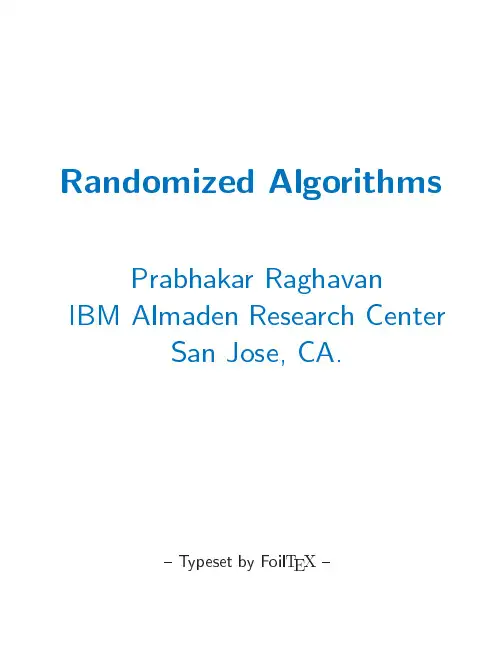
TUXEDO超时控制全功略二零零四年四月目录摘要: (6)1前言 (6)2全功略解读 (6)2.1SCANUNIT (6)2.1.1参数出处 (6)2.1.2时间单位 (6)2.1.3取值范围 (6)2.1.4默认取值 (6)2.1.5用途解释⑴ (6)2.1.6超时后果 (7)2.1.7设置考虑 (7)2.2SANITYSCAN (7)2.2.1参数出处 (7)2.2.2时间单位 (7)2.2.3取值范围 (7)2.2.4默认取值 (7)2.2.5用途解释⑵ (7)2.2.6超时后果 (7)2.2.7设置考虑 (7)2.3BBLQUERY (8)2.3.1参数出处 (8)2.3.2时间单位 (8)2.3.3取值范围⑶ (8)2.3.4默认取值 (8)2.3.5用途解释⑷ (8)2.3.6超时后果⑸ (8)2.3.7设置考虑 (8)2.4DBBLWAIT (8)2.4.1参数出处 (8)2.4.2时间单位 (8)2.4.3取值范围 (8)2.4.4默认取值 (8)2.4.6超时后果⑺ (9)2.4.7设置考虑 (9)2.5BLOCKTIME (9)2.5.1参数出处 (9)2.5.2时间单位 (9)2.5.3取值范围 (9)2.5.4默认取值 (9)2.5.5用途解释 (9)2.5.6超时后果 (10)2.5.7设置考虑 (10)2.6WSL CLOPT[-T C LIENT_TIMEOUT] (10)2.6.1参数出处 (10)2.6.2时间单位 (10)2.6.3取值范围 (10)2.6.4默认取值 (10)2.6.5用途解释⑻ (10)2.6.6超时后果⑼ (11)2.6.7设置考虑 (11)2.7WSL CLOPT[-T TIMEOUT] (11)2.7.1参数出处 (11)2.7.2时间单位 (11)2.7.3取值范围 (11)2.7.4默认取值 (11)2.7.5用途解释 (11)2.7.6超时后果 (11)2.7.7设置考虑 (11)2.8WSL CLOPT[-I INIT_TIMEOUT] (11)2.8.1参数出处 (11)2.8.2时间单位 (12)2.8.3取值范围 (12)2.8.4默认取值 (12)2.8.5用途解释⑽ (12)2.8.6超时后果 (12)2.8.7设置考虑 (12)2.9WSL CLOPT[-N NETWORK_TIMEOUT] (12)2.9.1参数出处 (12)2.9.2时间单位 (12)2.9.3取值范围 (12)2.9.5用途解释 (12)2.9.6超时后果 (13)2.9.7设置考虑 (13)2.10SVCTIMOUT (13)2.10.1参数出处 (13)2.10.2时间单位 (13)2.10.3取值范围 (13)2.10.4默认取值 (13)2.10.5用途解释 (14)2.10.6超时后果 (14)2.10.7设置考虑 (14)2.11GRACE (14)2.11.1参数出处 (14)2.11.2时间单位 (14)2.11.3取值范围 (14)2.11.4默认取值 (14)2.11.5用途解释 (14)2.11.6超时后果 (15)2.11.7设置考虑 (15)2.12T RANSACTION T IME O UT (15)2.12.1参数出处 (15)2.12.2时间单位 (15)2.12.3取值范围 (15)2.12.4默认取值 (15)2.12.5用途解释 (15)2.12.6超时后果 (16)2.12.7设置考虑 (16)2.13TRANTIME (16)2.13.1参数出处 (16)2.13.2时间单位 (16)2.13.3取值范围 (16)2.13.4默认取值 (16)2.13.5用途解释 (16)2.13.6超时后果 (16)2.13.7设置考虑 (17)2.14ORACLE XA OPENINFO参数:SESTM (17)2.14.1参数出处 (17)2.14.2时间单位 (17)2.14.4默认取值 (17)2.14.5用途解释 (17)2.14.6超时后果 (17)2.14.7设置考虑 (18)2.15ORACLE XA OPENINFO参数:SESWT (18)2.15.1参数出处 (18)2.15.2时间单位 (18)2.15.3取值范围 (18)2.15.4默认取值 (18)2.15.5用途解释 (18)2.15.6超时后果 (19)2.15.7设置考虑 (19)2.16ORACLE SQLNET.EXPIRE_TIME (19)2.16.1参数出处 (19)2.16.2时间单位 (19)2.16.3取值范围 (20)2.16.4默认取值 (20)2.16.5用途解释⑾ (20)2.16.6超时后果 (20)2.16.7设置考虑 (20)2.17ORACLE DISTRIBUTED_LOCK_TIMEOUT (21)2.17.1参数出处 (21)2.17.2时间单位 (21)2.17.3取值范围 (21)2.17.4默认取值 (21)2.17.5用途解释 (21)2.17.6超时后果 (21)2.17.7设置考虑 (21)2.18ORACLE M AX_COMMIT_PROPAGATION_DELAY (22)2.18.1参数出处 (22)2.18.2时间单位 (22)2.18.3取值范围 (22)2.18.4默认取值 (22)2.18.5用途解释 (22)2.18.6超时后果 (22)2.18.7设置考虑 (22)3总结 (23)4后记 (23)5参考文献 (23)TUXEDO超时控制全功略摘要:本《功略》集中了TUXEDO应用中,可能涉及到的所有时间参数,并分别对其进行详细描述,不但对其出处、取值等基本属性进行查证,而且,通过分析其内在的控制机制,给出设置建议,以期能够达到透彻理解、方便查阅、准确使用的目的。
【转】Deadlock的⼀些总结(死锁分析及处理)1.1.1 摘要在系统设计过程中,系统的稳定性、响应速度和读写速度⾄关重要,就像那样,当然我们可以通过提⾼系统并发能⼒来提⾼系统性能总体性能,但在并发作⽤下也会出现⼀些问题,例如死锁。
今天的博⽂将着重介绍死锁的原因和解决⽅法。
1.1.2 正⽂定义:死锁是由于并发进程只能按互斥⽅式访问临界资源等多种因素引起的,并且是⼀种与执⾏时间和速度密切相关的错误现象。
的定义:若在⼀个进程集合中,每⼀个进程都在等待⼀个永远不会发⽣的事件⽽形成⼀个永久的阻塞状态,这种阻塞状态就是死锁。
死锁产⽣的必要条件:1.互斥mutual exclusion):系统存在着临界资源;2.占有并等待(hold and wait):已经得到某些资源的进程还可以申请其他新资源;3.不可剥夺(no preemption):已经分配的资源在其宿主没有释放之前不允许被剥夺;4.循环等待(circular waiting):系统中存在多个(⼤于2个)进程形成的封闭的进程链,链中的每个进程都在等待它的下⼀个进程所占有的资源;图1死锁产⽣条件我们知道哲学家就餐问题是在计算机科学中的⼀个经典问题(并发和死锁),⽤来演⽰在并⾏计算中多线程同步(Synchronization)时产⽣的问题,其中⼀个问题就是存在死锁风险。
图2哲学家就餐问题(图⽚源于wiki)⽽对应到数据库中,当两个或多个任务中,如果每个任务锁定了其他任务试图锁定的资源,此时会造成这些任务阻塞,从⽽出现死锁;这些资源可能是:单⾏(RID,堆中的单⾏)、索引中的键(KEY,⾏锁)、页(PAG,8KB)、区结构(EXT,连续的8页)、堆或B树(HOBT) 、表(TAB,包括数据和索引)、⽂件(File,数据库⽂件)、应⽤程序专⽤资源(APP)、元数据(METADATA)、分配单元(Allocation_Unit)、整个数据库(DB)。
假设我们定义两个进程P1和P2,它们分别拥有资源R2和R1,但P1需要额外的资源R1恰好P2也需要R2资源,⽽且它们都不释放⾃⼰拥有的资源,这时资源和进程之间形成了⼀个环从⽽形成死锁。
死锁问题及其解决方法一、死锁的介绍死锁(Deadlocks)通常发生在两个或多个进程(sessions)对被彼此锁住的资源发出请求的情况下。
其最常见的锁的类型为:行级锁(row-level locks)和块级锁(block-level locks)。
ORACLE会自动侦察到死锁情况,并通过回滚其中一个造成死锁的语句,从而释放其中一个锁来解决它,如上图中的C时间所示。
需要说明的,如果一个事务中的某个语句造成死锁现象,回滚的只是这个语句而不是整个事务。
二、行级死锁及其解决方法行级锁的发生如下图所示,在A时间,Transacrion1和Transction2分别锁住了它们要update的一行数据,没有任何问题。
但每个Transaction都没有终止。
接下来在B时间,它们又试图update当前正被对方Transaction锁住的行,因此双方都无法获得资源,此时就出现了死锁。
之所以称之为死锁,是因为无论每个Transaction等待多久,这种锁都不会被释放。
行级锁的死锁一般是由于应用逻辑设计的问题造成的,其解决方法是通过分析trace文件定位出造成死锁的SQL语句、被互相锁住资源的对象及其记录等信息,提供给应用开发人员进行分析,并修改特定或一系列表的更新(update)顺序。
以下举例说明出现行级死锁时如何定位问题所在。
1.环境搭建create table b (b number);insert into b values(1);insert into b values(2);commit;session1: update b set b=21 where b=2;session2: update b set b=11 where b=1;session1: update b set b=12 where b=1;session2: update b set b=22 where b=2;此时出现死锁现象。
OBCA练习题51. 系统管理员可以根据业务需要创建不同的租户租户具有哪些特性? *A、可以创建自己的用户(正确答案)B、可以创建数据库、表等所有对象(正确答案)C、有独立的information_ schema等系统数据库(正确答案)D、有自己独立的系统变量(正确答案)2. 租户扩容的方法有哪几种? *A、诵过增加系统可用性(如:三副本扩容至五副本)B、通过增大资源池Unit Num(正确答案)C、涌过向集群中增加新的OBServer3. OB支持多种级别的高可用和容灾可以进行如下哪些高可用和容灾部署形式? *A、两地三中心(正确答案)B、同城两机房C、同城三机房(正确答案)D、三地五中心(正确答案)4. 关于OceanBase 的负载均以下说法正确的是? *A、负载均衡i的调度单元是数据库(database)B、负载均衡的调度单元是分区(Partition)(正确答案)C、系统根据一定的策略通过动态调整UNIT的位置和UNIT内副本的位置使得1个Zone(正确答案)D、OceanBase自动完成负载均衡,无法关闭E、负载均衡的调度单元是资源单元(Unit)F、负载均衡的调度单元是租户5. OceanBase租户支持的事务隔离级别包括以下哪些? *A、读已提交(read-committed)(正确答案)B、可重复读(repeatable-read)(正确答案)C、串行(Serializable)(正确答案)D、不可重复读(non repeatable-read)6. OceanBase数据库支持动态调整租户容量,可以调整单节点的服务能力,也可以调节服务器节点个数。
前者对应... [判断题] *对(正确答案)错7. 分区是OceanBase数据架构的基本单元,是传统数据库的分区表在分布式系统上的实现 [判断题] *对(正确答案)错8. 以下关于变量描述不正确的是? [单选题] *A、用来控制租户全局(global)级别或者会话(session)级别的属性B、大部分动态生效,少部分需要重建连接C、可以通过show variables;查看变量D、修改全局变量之后不需要重新建立会话,在当前会话即可生效(正确答案)9. “major_freeze_duty_ime”设置为“02:00”意味着什么? [单选题] *A、每日凌晨2点,系统自动发起一次内存冻结操作B、每日凌晨2点,系统自动发起一次备份恢复操作C、每日凌晨2点,系统自动发起一次合并操作(正确答案)D、每日凌晨2点系统自动发起一次转储操作10. 下列有关变量设置描述正确的是? [单选题] *A、设置 Session级别的变量对当前 Session有效,对其他 Session无效(正确答案)B、设置Global级别和Session级别的变量效果是一样的C、设置Global级别的变量对当前Session有效D、设置Session级别的变量,对所有的Session都有效11. 应用通过OBProxy连接到OceanBase集群,比直连主副本所在的OBServer性能更好? [判断题] *对错(正确答案)12. 关于OceanBase的负载均衡,以下说法正确的是 *A、系统根据一定的策略,通过动态调整UNIT的位置和UNIT内副本的位置,使得一个Zone内所有Server的资源使用率达到均衡的过程(正确答案)B、OceanBase自动完成负载均衡,无法关闭C、负载均衡的调度单元是租户D、负载均衡的调度单元是数据库(database)(正确答案)E、负载均衡的调度单元是资源单元(Unit)F、负载均衡的调度单元是分区(Partition)13. 假如OBServer进程异常终止,会通过server_permanentoffline time参数值来判断后续的处理策略,以下描述正确的有哪些? *A、当进程异常终止持续时间<server_permanent_offline_time,此时已缺失部分副本,虽然依然满足多数派,可以保证RPO=0,但存在一定的风险(正确答案)B、当进程异常终止持续时间>server_permanent_ofline_time,会将机器做"临时下线"处理,从其它zone的主副本中,将缺失的数据复制到本zone内剩余的机器上(需要有足够的资源),以维持副本个数(正确答案)C、当进程异常终止持续时间>server_permanent_offline_time,异常终止的observer进程恢复后会自动加入集群,如果已经做过"临时下线"处理,需要从本zone内其它机器上(或者其它zone内)将unit迁移过来D、当进程异常终止持续时间< server_permanent_offline_time,OceanBase暂时不做补副本的处理,以避免频繁的数据迁移14. 普通租户只能设置自己租户的参数,系统租户可以查看和设置所有租户的参数(包括系统租户和普通租户)。
银⾏家算法(安全序列)银⾏家算法银⾏家算法(Banker's Algorithm)是⼀个避免死锁(Deadlock)的著名算法,是由艾兹格·迪杰斯特拉在1965年为T.H.E系统设计的⼀种避免死锁产⽣的算法。
它以银⾏借贷系统的分配策略为基础,判断并保证系统的安全运⾏。
安全状态如果存在⼀个由系统中所有进程构成的安全序列P1,…,Pn,则系统处于安全状态。
安全状态⼀定是没有死锁发⽣。
不安全状态不存在⼀个安全序列。
不安全状态不⼀定导致死锁。
数据结构1)可利⽤资源向量Available是个含有m个元素的数组,其中的每⼀个元素代表⼀类可利⽤的资源数⽬。
如果Available[j]=K,则表⽰系统中现有Rj类资源K个。
2)最⼤需求矩阵Max这是⼀个n×m的矩阵,它定义了系统中n个进程中的每⼀个进程对m类资源的最⼤需求。
如果Max[i,j]=K,则表⽰进程i需要Rj类资源的最⼤数⽬为K。
3)分配矩阵Allocation这也是⼀个n×m的矩阵,它定义了系统中每⼀类资源当前已分配给每⼀进程的资源数。
如果Allocation[i,j]=K,则表⽰进程i当前已分得Rj类资源的数⽬为K。
4)需求矩阵Need。
这也是⼀个n×m的矩阵,⽤以表⽰每⼀个进程尚需的各类资源数。
如果Need[i,j]=K,则表⽰进程i还需要Rj类资源K个,⽅能完成其任务。
Need[i,j]=Max[i,j]-Allocation[i,j]算法原理我们可以把操作系统看作是银⾏家,操作系统管理的资源相当于银⾏家管理的资⾦,进程向操作系统请求分配资源相当于⽤户向银⾏家贷款。
为保证资⾦的安全,银⾏家规定:(1) 当⼀个顾客对资⾦的最⼤需求量不超过银⾏家现有的资⾦时就可接纳该顾客;(2) 顾客可以分期贷款,但贷款的总数不能超过最⼤需求量;(3) 当银⾏家现有的资⾦不能满⾜顾客尚需的贷款数额时,对顾客的贷款可推迟⽀付,但总能使顾客在有限的时间⾥得到贷款;(4) 当顾客得到所需的全部资⾦后,⼀定能在有限的时间⾥归还所有的资⾦.操作系统按照银⾏家制定的规则为进程分配资源,当进程⾸次申请资源时,要测试该进程对资源的最⼤需求量,如果系统现存的资源可以满⾜它的最⼤需求量则按当前的申请量分配资源,否则就推迟分配。
A Distributed Algorithm for Deadlock Detection and ResolutionDon P.Mitchell †Michael J.Merritt †AT&T Bell LaboratoriesABSTRACTThis paper presents two distributed algorithms for detecting and resolving dead-locks. By insuring that only one of the deadlock processes will detect it, the problem ofresolving the deadlock is simplified.That process could simply abort itself.In one ver-sion of the algorithm, an arbitrary process detects deadlock; and in a second version, theprocess with the lowest priority detects deadlock.1. IntroductionA system of processes is deadlocked when a cycle forms in its wait-for graph.One method of deal-ing with this problem is to allow deadlocks to form but to detect them quickly and abort a process to break the cycle. If the system is local to a single site, a central resource-management process can accomplish this. All other processes request resources from the manager which maintains a representation of the wait-for graph and watches for cycle formation.There are two problems with this approach.First, the whole system is vulnerable to the failure of the management process; and second, message passing to and from the manager is expensive.If the system is distributed over many sites, these two problems are much more severe. Although message passing is becoming cheaper,the issue of fault tolerance will certainly remain.A number of distributed algorithms for deadlock detection have been published, and they seem to fall into two categories. Those in the first category pass information about process demands in an attempt to maintain relevant parts of the global wait-for graph on each site[MENASCE79, GLIGOR80, OBERMARCK82].The second category of algorithms was inspired by work on parallel graph algorithms[DIJKSTRA80, CHANG82].In this category simpler messages are passed from process to process[CHANDY82, BRACHA83].The global wait-for graph is not explicitly built up; however, a cycle in the graph will ultimately cause mes-sages to return to their initiators thus alerting them to the existence of deadlock.The algorithms presented in this paper fall into this second category.An important advantage of these algorithms over earlier work is that only one process in a cycle will detect the deadlock, simplifying the problem of resolving the deadlock.A second advantage rests in their simplicity.Indeed, one author implemented the first algorithm in a local database system in under an hour.They are just as simple to analyse. Even in the face of lost messages and process failures, the correctness proofs are trivial.2. The System ModelThe system can be described by the wait-for graph,a directed graph in which each node represents a pro-cess, and an edge indicates that one process is waiting on a resource held exclusively by another.Assuming each process waits on one resource at a time, the maximum outdegree of the wait-for graph will be one. The direction of the edges are from the waiting process to the process holding the desired resource.Each node is given two labels. Thefirst (indicated by an index in the lower half of the node) is a pri-vate label that is unique to the node thought not necessarily constant.The second label (indicated by an †Address: AT&T Bell Laboratories, 600 Mountain Ave., Murray Hill, NJ 07974.index in the upper half of the node) is public.It represents a number that can be read by other processes, and the same value may appear in other nodes.The edges and labels define the state of the system at any moment.3. Simple Deadlock DetectionBlockuSTATE BEFORE outdegree=0vActivate TransmitDetectFigure1Figure 1 shows the four types of nondeterministic state transitions that define this algorithm.The function "inc(x,y)", means a value larger than both x and y that is unique to that bel values which neither are a precondition for a transition nor change as a result of a transition have been left blank.Each process begins with its private label equal to its public label.The private label of each node is always unique to that node, and non-decreasing over time. These two properties can be easily realized by keeping the low-order bits of the label constant and unique while increasing the high-order bits when desired.The Block step occurs when a process begins to wait on some resource held by another,creating an edge in the wait-for graph.One of the crucial features of this algorithm is the label change that occurs then. Both the public and private labels of the waiting process increase to a value greater than their previous val-ues and greater than the public label of the process being waited on.The private and public labels of the node are changed to the same new value.The Activate step means that an edge disappeared because a process got a resource, or timed out and gave up waiting, or failed. This step also occurs if the owner of a resource changes.When the waiting pro-cess notices that, it must Activate and then Block again if it is to continue waiting for that resource.The Tr a nsmit step occurs when the waiting process reads the public label of the process it is waiting on and discovers that it is larger than its own. In that case, the waiting process replaces its own public label with the one it just read.One effect of this is that larger labels tend to migrate (in the opposite direction) along the edges of the wait-for graph.The Detect step means that a process sees its own public label come back and knows that it is part of a cycle. A cycle of N processes will be detected after N−1Transmit steps.Only one process in a cycle will detect deadlock which simplifies the problem of resolution.The process could simply abort (or at least, release its resources) to break the deadlock, or it could initiate some other deadlock resolution scheme.4. A Proof of CorrectnessLemma 1:As in the figure above,if there is an edge between two nodes and u>w then u=v.Proof:The definition of the Block step guarantees that this will be true when an edge first forms.The only way the label u will change during the lifetime of that edge is if a Transmit step is executed, and that will not happen as long as u>w,and w is nondecreasing over time.Lemma 2:At the instant a cycle forms, the public labels of the nodes in it do not all have the same value.Proof:When the cycle forms, the last edge (like all edges) is created by a node executing the Block step.That node will have a new public label different from any other public label because the inc function generates unique values.Lemma 3:The maximum public label value in a cycle is equal to the private label of one and only one node in the cycle.Proof:By Lemma 2 when a cycle forms, all the public labels cannot have the maximum value. At least one node with maximum public label value must precede a node with a different, lower public label.Thus by Lemma 1, the private label of the preceding node must equal the maximum label value. Since no Block operations can be performed by nodes in a cycle, this will remain true throughout its lifetime.Private labels are unique, so only one node can obey this condition.Theorem 1:If a cycle of N nodes forms and persists long enough, exactly one node in it will execute the Detect step of the algorithm.This will happen after N−1consecutive Transmit steps.Proof:If a cycle forms and does not break on its own,N−1Transmit steps will carry the largest public label value all the way around the cycle. By Lemma 3, this means one and only one node will eventually execute the Detect step.5. Aborting Low-Priority TransactionsThe algorithm just presented suffers from a significant drawback if the detecting process aborts to break deadlock.Since older processes tend to have larger label numbers, they are more likely to become the detecting process in a cycle. A designer may wish to assign a unique priority,p i,to each process i,on the basis of age, number of locks held, or other criteria, and select the process with the lowest priority in the cycle to be aborted.This is exactly the function provided by the following algorithm.Block upSTATE BEFOREoutdegree =0STATE AFTER ActivateTransmit(u <v )or (u =v ,p>q )Detect Figure 2This algorithm is an extension of the last algorithm; unique public and private priority numbers have been added.In the figure above,public labels and priority numbers appear as the top left and right values in a node, and the private labels and priority numbers are the bottom left and right values, respectively.Ini-tially,each process posts its unique private label and priority number.Nodes with equal public labels post the lower priority number (the Transmit step) and a node aborts when it sees its own private priority number together in a node with its own public label (the Detect step).This algorithm aborts the lowest-priority process in any cycle that doesn’t break on its own. Since the process with the highest public label may be waiting for a lock held by the lowest-priority process, the low-priority number may not start propagating around the cycle until after the public label has gone full-cir-cle. Thus,this algorithm can take up to twice as long to detect deadlock as the first algorithm.Theorem 2:If a cycle of N nodes forms and persists long enough, the lowest priority process in the cycle will execute the Detect step after at least N −1and at most 2N −2consecutive Transmit steps.The proof of this theorem is similar to that of Theorem 1.6. DiscussionIn these algorithms, only one deadlocked process detects deadlock.This clears up the problem of deciding which process should initiate deadlock resolution.The detecting process could simply abort to break deadlock.In the first algorithm, an arbitrary process detects deadlock; and in the second, the process with lowest priority in the cycle will detect.These algorithms do not use synchronized message passing.When one process posts a value in its public label, there is no guarantee that another process (executing the Transmit step) will read it before it is replaced by a new value. It is assumed that successive reads of a label will yield successive values; never out of order.Process failures (in which all resources held are released) will not cause deadlocks to persist, but they may lead to false deadlock detection.This happens when the cycle has already been broken (by a time-outor failure) when the deadlock is detected.Indeed, an actual cycle may never hav e existed in any single sys-tem state.If this is a problem in some applications, the deadlock-detecting process could initiate some type of cycle checking.Passing another set of messages around the cycle could at least guarantee that a real cycle existed at some point in time.This paper assumes a system in which no central management of resources exists, but in which resources can be locked. Such a system has many advantages, but is open to livelock conditions.The first algorithm has been implemented in an experimental database system and has performed well.References[BRACHA83] Bracha,Gabriel, Sam Toueg, "A Distributed Algorithm For Generalized Deadlock Detection," TR 83-558, June 1983, Department of Computer Science, Cornell Uni-versity.[CHANDY82] Chandy,K.M., J. Misra, "A Distributed Algorithm for Detecting Resource Dead-locks in Distributed Systems," ACM SIGACT-SIGOPS Symposium on Principles ofDistributed Computing, August 1982, Ottawa,Canada.[CHANG82] Change,Ernest J. H., "Echo Algorithms: Depth Parallel Operations on General Graphs,"IEEE Transactions on Software Engineering,V ol. SE-8, No. 4, July 1982.[DIJKSTRA80] Dijkstra,Edsger W., C. S. Scholten, "Termination Detection for Diffusing Computa-tions,"Information Processing Letters,V ol. 11, No. 1, August 1980.[GLIGOR80] Gligor,Virgil and Susan H. Shattuck, "On Deadlock Detection in Distributed Sys-tems,"IEEE Transactions on Software Engineering,V ol. SE-6, No. 5, September1980.[MENASCE79] Menasce,Daniel and Richard Muntz, "Locking and Deadlock Detection in Dis-tributed Data Bases,"IEEE Transactions on Software Engineering,V ol. SE-5, No. 3,May 1979.[OBERMARCK82] Obermarck,Ron, "Distributed Deadlock Detection Algorithm,"ACM Transactions on Database Systems,V ol. 7, No. 2, June 1982.。